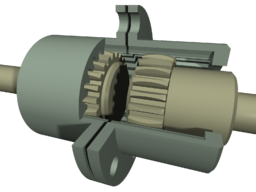 If asked to define G couplings, the average man or woman on the street might speculate that G couplings occur between members of a Homie-G’s entourage. However, engineers, factory managers and maintenance technicians know better. They understand that G couplings connect different parts of heavy-duty machinery. This article explains just what a G coupling is, and also lists applications for different types of G couplings.
If asked to define G couplings, the average man or woman on the street might speculate that G couplings occur between members of a Homie-G’s entourage. However, engineers, factory managers and maintenance technicians know better. They understand that G couplings connect different parts of heavy-duty machinery. This article explains just what a G coupling is, and also lists applications for different types of G couplings.
What are G couplings?
To understand this question, we must first understand just what a coupling is. At its most basic, a coupling is a transmitter of power. Couplings are used to connect two shafts in mechanical applications. That sounds simple, but selecting the correct coupling for a specific industrial setting can be very complicated, due to the fact that a coupling system must be able to accommodate some misalignment and movement while still sealing together two disparate moving parts.
Beyond the basic purpose of holding together two shafts, couplings accomplish the following:
- Reduction of shock loads between shafts.
- Defense from overload. If a system is running too hot or too fast, a major mechanical catastrophe could occur. Some couplings help prevent the need for costly repairs by disconnecting or slipping when a certain level of torque is surpassed.
- Shifting vibration of turning parts. Vibration is key in industrial machinery; it is like a heartbeat for the entire mechanical system. Some couplings can alter the vibration output, thereby reducing the amount of repair required.
- Mechanical flexibility and allowance for misalignment. Couplings can facilitate operations even when shaft misalignment and movement are present.
G couplings, also known as gear couplings, are a specific type of coupling that is often used in high-torque, high-horsepower situations. A G coupling does not typically include a grid, which is a kind of net that is sometimes located within a coupling system. Compared to universal joints, gear couplings can typically withstand more torque, while universal joints cause lower vibrations. The basic structure of a G coupling is two hubs with external and internal teeth and a one- or two-piece sleeve.
Types of Falk G couplings and their Applications
Many maintenance technicians choose Falk coupling systems such as Lifelign Gear Couplings. Falk couplings are known for their unparalleled bore capacities and torque ratings. Indeed, many engineers find they can use smaller Falk couplings because they are so strong; this is especially handy in applications where space is limited. Other top-of the line characteristics of Falk couplings include triple reinforcement in gear teeth and zinc-coated fasteners to prevent corrosion.
As you can see, the quality of G couplings varies according to manufacturer. However, there are also several different G coupling designs:
Rigid couplings. These are perfect when misalignment is not an issue and when thrust loads are high.
Floating shaft assemblies. These allow shaft connections across long distances. For instance, if you have an engine that needs to operate a fan located 15 feet away and there’s no place to mount supports for the connecting shaft, a floating shaft assembly is a good solution.
Slide couplings. These are used in circumstances where some axial movement is needed and thermal shaft expansion must also be accounted for.
Shear pin couplings. These are ideal in systems that tend to overload or become jammed. When the pin inside the coupling breaks, the equipment can no longer run. This prevents damage by stopping the system as soon as loads become dangerously high.
Disconnect couplings. These are similar to shear pin couplings in that they can disconnect quickly according to the situation at hand. Disconnect couplings may be used in both low- and high-speed applications.
These are only a few of the varieties of G couplings available today. One thing holds true for all of these coupling systems: They will last much longer with proper maintenance.
How to Care for Your G couplings
Gear coupling systems are costly to replace – and when equipment is down, production time and money are lost. Preventative maintenance is essential in caring for Falk couplings as well as those of other brands. To make sure your Falk coupling system runs smoothly, install it with as much alignment as possible. This will leave you some wriggle room for natural shifts later on.
One more thing to remember: G couplings are lubrication sensitive. Falk couplings are designed so that lubrication holes are near the gear coupling’s tooth mesh; this means there will be enough grease in the lube reservoir to create a smooth startup.
[ Photo by Petteri Aimonen, via Wikimedia Commons ]
Posted under Products/Services on Monday, January 30th, 2012
